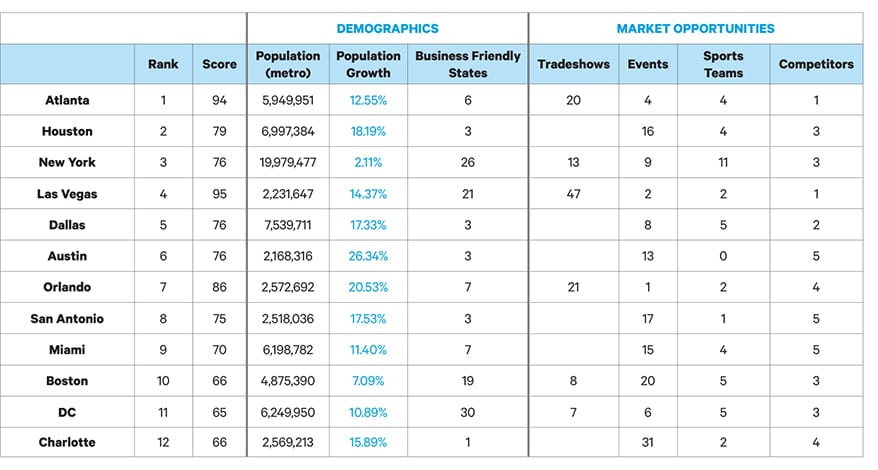FOR MORE THAN 100 years, Olympus Group had one location in Milwaukee, Wisconsin. For more than 20 years, Screaming Images had one location in Las Vegas. We produced 100 percent of our respective products in our single spaces. We each dealt with one set of headaches regarding leaky roofs, parking lot repairs, HVAC upkeep, power outages, and the slew of issues that come along with running a print facility.
Back in 2011, with wide-format lead times compressing from weeks to days to hours, some bozo at Olympus (likely Brian) had a great idea: Let’s expand and open a second location in Orlando. Walt Disney World was one of Olympus Group’s most important and largest customers, and there was potential in the Orlando tradeshow market. So, in 2011, Olympus Group took the plunge and opened a second facility. “We did not know what we were getting ourselves into (ignorance is bliss), but we felt geographic expansion was the best path forward for growth and for our team,” Brian Adam says. “We conducted some mediocre market research, spent a couple of months finding a facility, invested a couple hundred thousand dollars in equipment, hired a handful of employees, and we were in business (or so we thought). Our move into Orlando was a catalyst for future expansion and in hindsight was one of the best business moves we ever made.”
Fast forward 12 years and Olympus Group has quintupled the number of headaches by expanding into Denver and Nashville and merging with Screaming Images in Las Vegas. Scaling to five print locations has led to countless new opportunities, opened new doors in key markets, and has helped support growth. However, it has all come at a cost.

Why Expand Geographically?
We believe wide-format printers can be classified in one of two ways – national or regional.
V National wide-format printers specialize in a certain market (such as retail/point-of-purchase) or have a specialty in one type of application (such as nationwide fleet graphic programs). National providers sell their products anywhere. Location matters (for shipping times and costs) but is not critical, and geographic expansion has less value.
Advertisement
V Regional suppliers tend to support local accounts (such as local sports teams, restaurants, universities, and events). The majority of business comes from the region, and having a local print facility is often essential.
Olympus Group and Screaming Images are regional suppliers. While we have some national clients, we service tradeshows, events, sports teams, and amusement parks. The vast majority of our customers are in Milwaukee, Orlando, Las Vegas, Denver, and Nashville. For our customers, it was essential we had a local print facility.
Acquisition vs. GreenField
There are two ways to expand geographically and there are pros and cons to each.
- Acquire a Business/Buy an Existing Company
advantages: The business is already set up with employees, equipment, a facility, and customers. You hit the ground running.
disadvantages: It can be very expensive. Integrating two different teams, companies, systems, and cultures is one of the toughest challenges a business will ever face.
- Greenfield, aka Open a New Facility from Scratch
advantages: You control everything from whom you hire to the equipment you purchase to the size of the facility. It typically costs less than an acquisition.
disadvantages:You’re starting from zero and often trying to steal market share. It will take longer to build the business.
Tips Learned Along The Way
- Do Your Homework
Understanding the potential of a market and how your organization fits in is critical. Be sure to investigate tax incentives – cities and states will often provide a financial incentive or tax break, but you need to line this up before you move. Take the time to speak with customers, suppliers, or even LinkedIn acquaintances about a location.
- Market Research
Make sure the location is a good fit for your business. A few things to consider: What’s the market size? How many current and potential customers are there? What are the demographics (aka is it a growing market)? What’s it like to do business there? What’s the tax environment? The regulatory environment? Is the market saturated with competitors? We weighed all variables to Olympus Group and then ranked the top 50 markets in the US (see chart).
- Plan To Be There – a Lot!
The frequency of visits was far greater than we anticipated. The only way to build relationships and connections is to physically be there. We try to ensure members of our executive team are at every location multiple times per month.
- Have a Strong Local Leader
View geographic expansion as a start-up. It’s going to be a tough job, demanding lots of hours, nights, and weekends while you grow. Invest in a strong general manager, plant manager, or sales lead excited about the opportunity to build something.
- Identical Equipment and Systems
As much as possible, try to have the same equipment and systems at the new location. This will allow you to share workload, troubleshoot issues, and even share people. For large events, we have flown production staff from one location to another to help support the local team.
- Culture
We underestimated how hard it is to build culture remotely. You will need to be intentional about this. Communication and providing frequent corporate updates are critical. Newsletters, email updates, and photos (new employees, cool projects, facility/equipment, etc.) are helpful in making everyone feel like they’re part of the same team.
- It’s Kind of Fun!
We’ve really enjoyed time in a new location, discovering a new market, meeting new people, and learning about the differences at each location. Theme parks in Orlando, casinos in Las Vegas, blue-collar Milwaukee, the music scene in Nashville, and outdoorsy Denver … our locations, and the people in each, are unique. For us, that’s part of the fun.

 Best of Wide Format2 months ago
Best of Wide Format2 months ago
 Best of Wide Format2 months ago
Best of Wide Format2 months ago
 Columns2 months ago
Columns2 months ago
 Blue Print2 weeks ago
Blue Print2 weeks ago
 Best of Wide Format2 months ago
Best of Wide Format2 months ago
 Best of Wide Format2 months ago
Best of Wide Format2 months ago
 Best of Wide Format2 months ago
Best of Wide Format2 months ago
 Best of Wide Format2 months ago
Best of Wide Format2 months ago





















